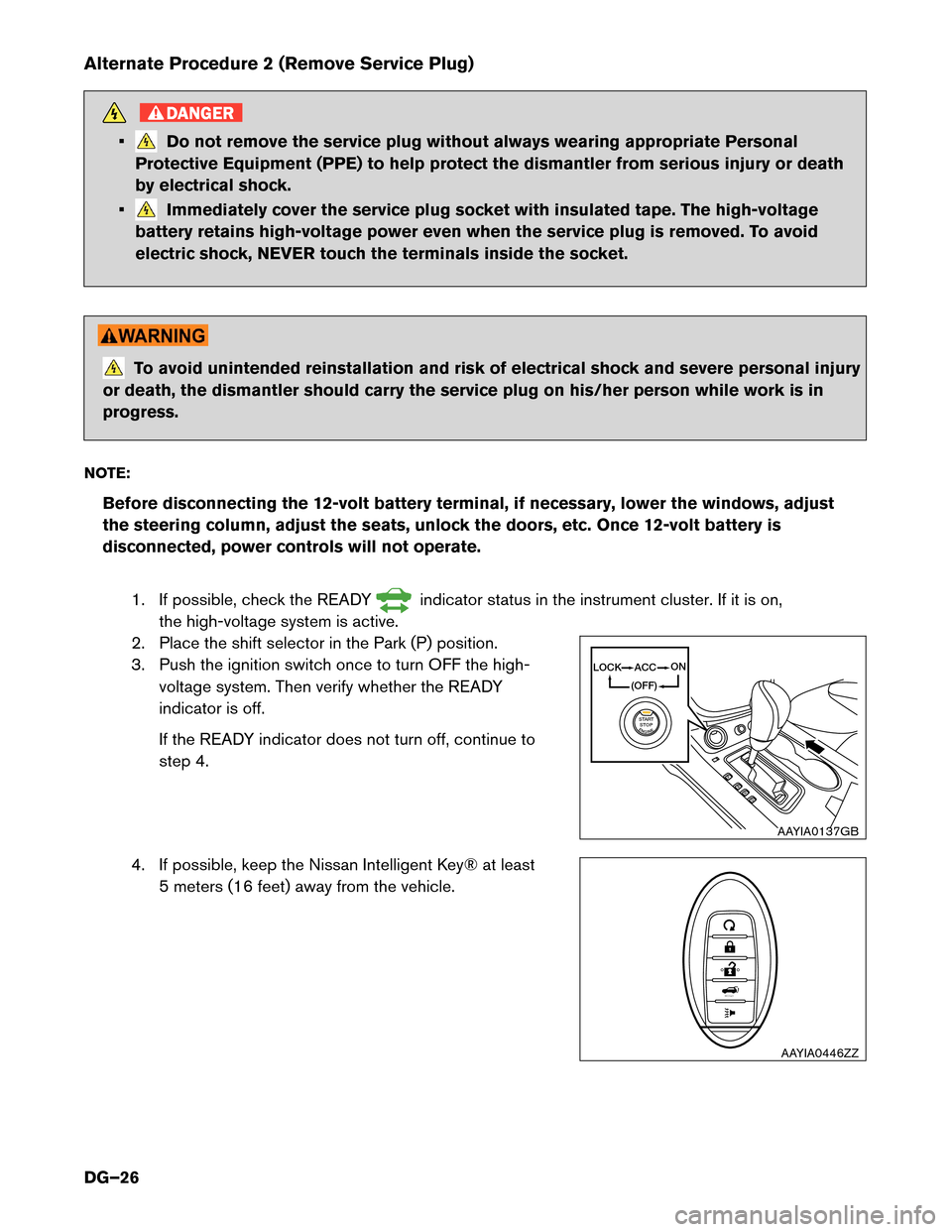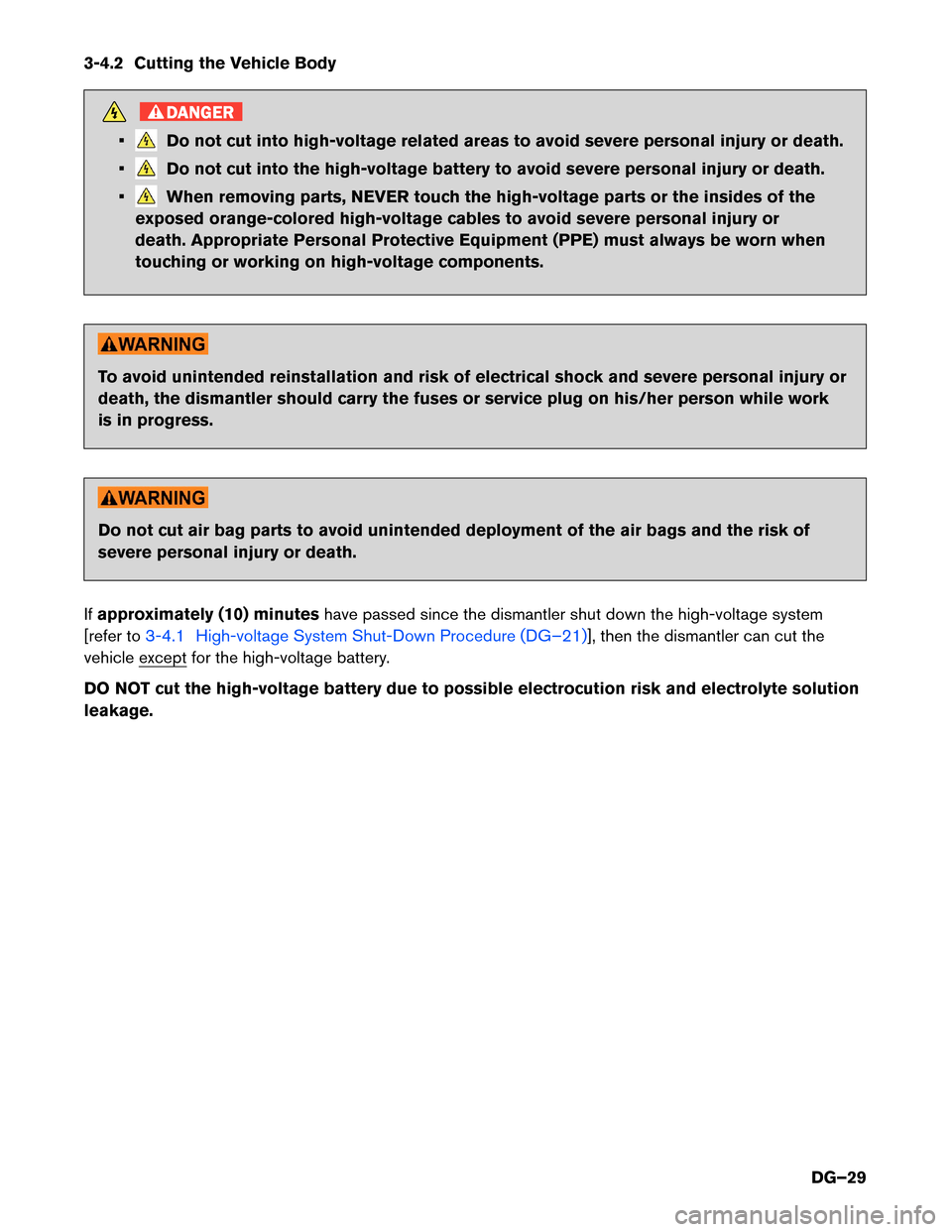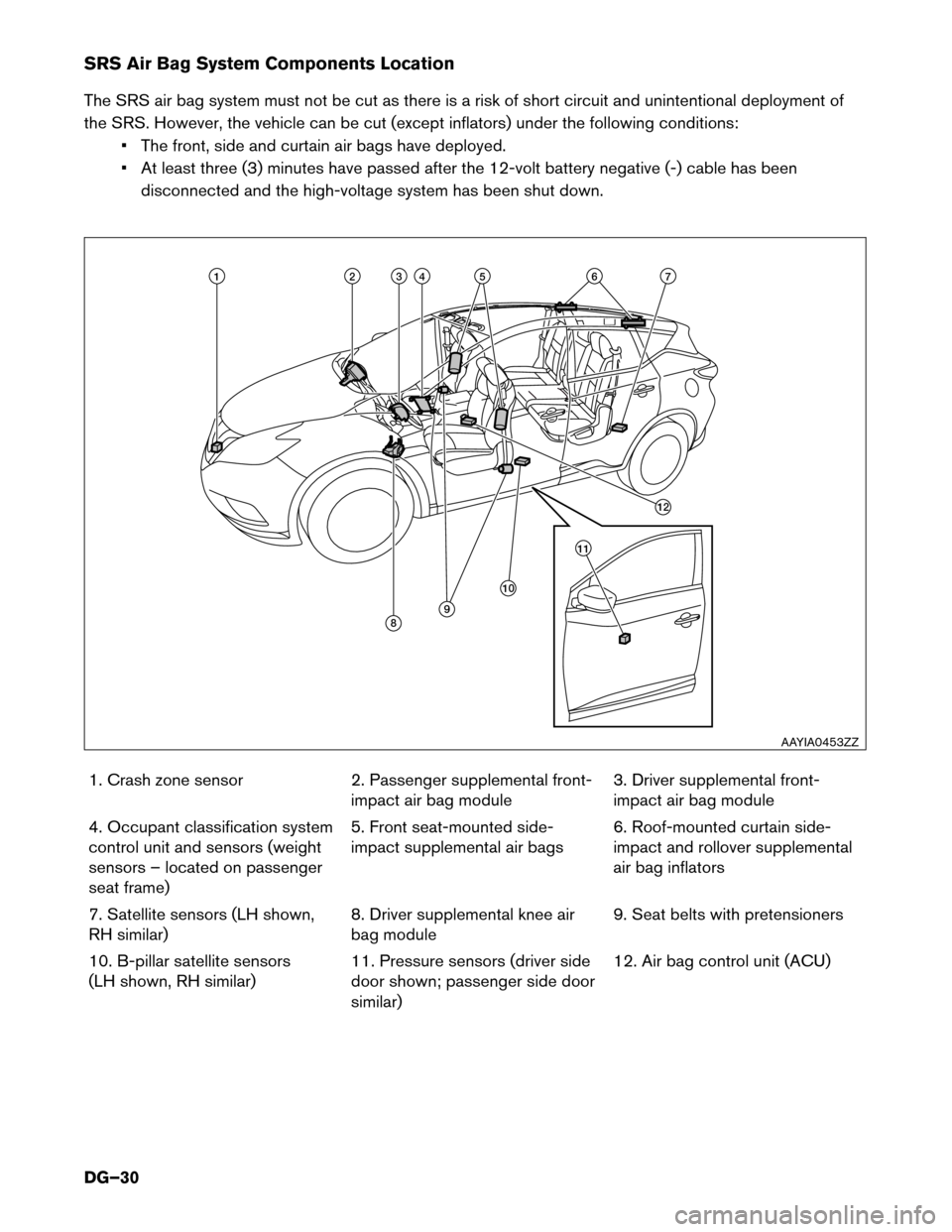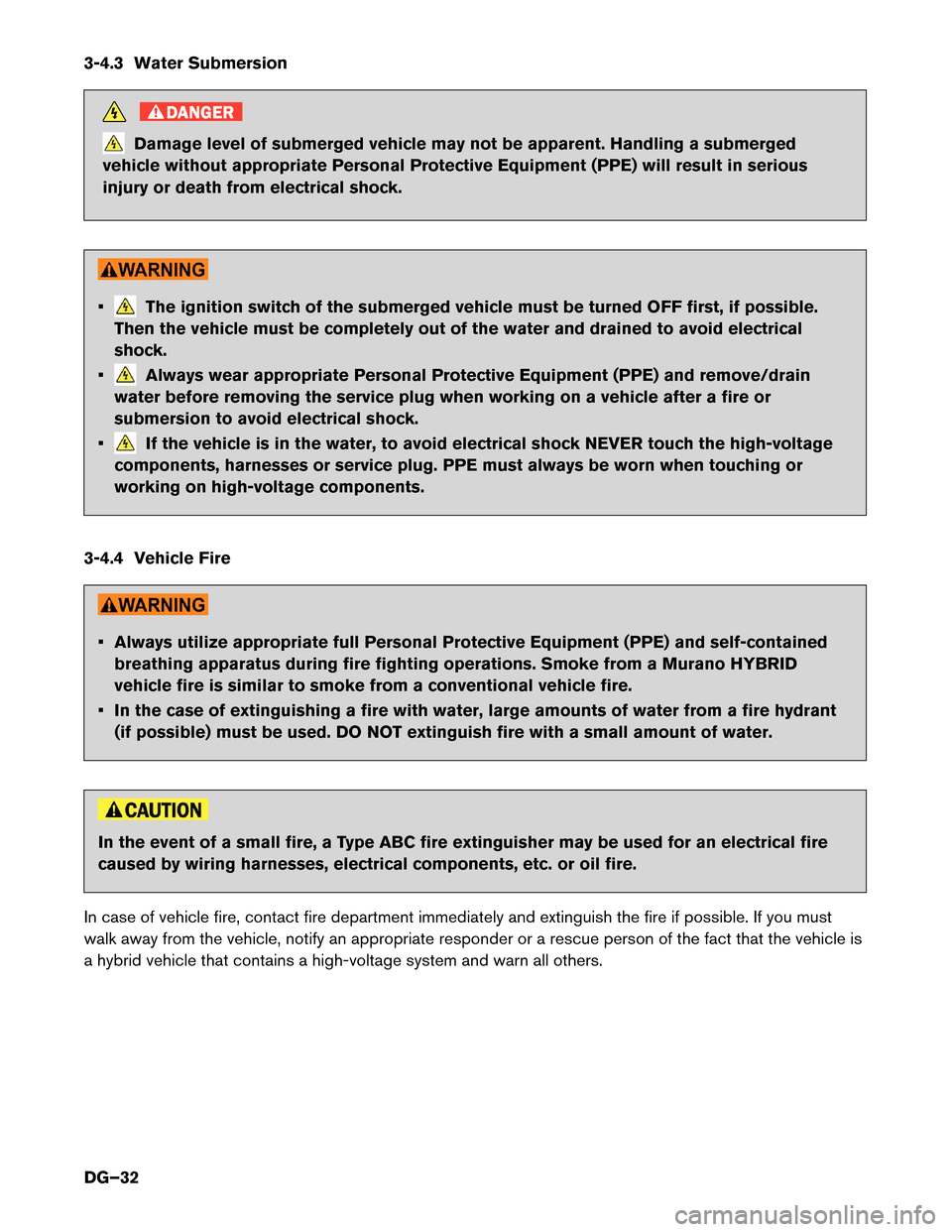Page 25 of 49
3. Remove IGCT RLY fuse (F/L IGCT RLY 50A) .
4.
If you cannot identify the correct fuse, remove all the
fuses. To avoid unintended reinstallation and risk of
electrical
shock and severe personal injury or death,
the dismantler should carry the fuse or fuses on his/her
person and cover the fuse box with insulated tape.
5. Remove traction motor inverter cover.
6. Disconnect negative (-) battery cable and cover it withinsulated tape.
7. Wait approximately ten (10) minutes for complete discharge of the high-voltage capacitor
after the fuse panel and battery cable have been disconnected.
8. Perform the dismantling operation. Refer to 6. Dismantling Information (DG–39). F/L V IGCT RLY 50A
(Red)
AAYIA0154GB AAYIA0447ZZ
AAYIA0274ZZ
DG–25
Page 26 of 49

Alternate Procedure 2 (Remove Service Plug)
DANGER
• Do not remove the service plug without always wearing appropriate Personal
Protective Equipment (PPE) to help protect the dismantler from serious injury or death
by electrical shock.
• Immediately cover the service plug socket with insulated tape. The high-voltage
battery
retains high-voltage power even when the service plug is removed. To avoid
electric shock, NEVER touch the terminals inside the socket. To avoid unintended reinstallation and risk of electrical shock and severe personal injury
or
death, the dismantler should carry the service plug on his/her person while work is in
progress.
NOTE: Before disconnecting the 12-volt battery terminal, if necessary, lower the windows, adjust
the steering column, adjust the seats, unlock the doors, etc. Once 12-volt battery is
disconnected, power controls will not operate.
1. If possible, check the READY indicator status in the instrument cluster. If it is on,
the
high-voltage system is active.
2. Place the shift selector in the Park (P) position.
3. Push the ignition switch once to turn OFF the high- voltage system. Then verify whether the READY
indicator is off.
If the READY indicator does not turn off, continue to
step 4.
4. If possible, keep the Nissan Intelligent Key® at least 5 meters (16 feet) away from the vehicle.
PR N
D ACC
ENGINESTART
STOP LOCK
(OFF)
ON
AAYIA0137GB
HOLD AAYIA0446ZZ
DG–26
Page 27 of 49
5. Open the center console and use a suitable tool to remove the service plug access cover.
6.
Remove the service plug (A)by pulling the locking lever (B), then pressing the locking tab (C)
and rotating the handle (D)fully outward. Using the handle, pull the service plug (E)completely
out of its socket.
7. Cover the service plug socket with insulated tape.
8. Wait approximately ten (10) minutes for complete discharge of the high-voltage capacitor
after the service plug has been removed. AAYIA0448ZZ
A B C
D E
AAYIA0450ZZ
DG–27
Page 28 of 49
9. Pull release handle located on the instrument panel and push the release lever under the hood
sideways to open hood.
10. Remove traction motor inverter cover.
11. Disconnect negative (-) battery cable and cover it with insulated tape.
12. Perform the dismantling operation. Refer to 6. Dismantling Information (DG–39). AAYIA0422ZZ
AAYIA0447ZZ
AAYIA0274ZZ
DG–28
Page 29 of 49

3-4.2 Cutting the Vehicle Body
DANGER
• Do not cut into high-voltage related areas to avoid severe personal injury or death.
• Do not cut into the high-voltage battery to avoid severe personal injury or death.
• When removing parts, NEVER touch the high-voltage parts or the insides of the
exposed orange-colored high-voltage cables to avoid severe personal injury or
death. Appropriate Personal Protective Equipment (PPE) must always be worn when
touching or working on high-voltage components. To avoid unintended reinstallation and risk of electrical shock and severe personal injury or
death,
the dismantler should carry the fuses or service plug on his/her person while work
is in progress. Do not cut air bag parts to avoid unintended deployment of the air bags and the risk of
severe
personal injury or death.
If approximately (10) minutes have passed since the dismantler shut down the high-voltage system
[refer to 3-4.1 High-voltage System Shut-Down Procedure (DG–21)], then the dismantler can cut the
vehicle
except for the high-voltage battery. DO NOT cut the high-voltage battery due to possible electrocution risk and electrolyte solution
leakage.
DG–29
Page 30 of 49

SRS Air Bag System Components Location
The
SRS air bag system must not be cut as there is a risk of short circuit and unintentional deployment of
the SRS. However, the vehicle can be cut (except inflators) under the following conditions: • The front, side and curtain air bags have deployed.
• At least three (3) minutes have passed after the 12-volt battery negative (-) cable has beendisconnected and the high-voltage system has been shut down.
1. Crash zone sensor 2. Passenger supplemental front-
impact air bag module 3. Driver supplemental front-
impact air bag module
4. Occupant classification system
control unit and sensors (weight
sensors – located on passenger
seat frame) 5. Front seat-mounted side-
impact supplemental air bags
6. Roof-mounted curtain side-
impact and rollover supplemental
air bag inflators
7. Satellite sensors (LH shown,
RH similar) 8. Driver supplemental knee air
bag module9. Seat belts with pretensioners
10. B-pillar satellite sensors
(LH shown, RH similar) 11. Pressure sensors (driver side
door shown; passenger side door
similar)12. Air bag control unit (ACU)1
8 10 12
92
113 4 75 6
AAYIA0453ZZ
DG–30
Page 31 of 49
Vehicle Cut Sheet(Monday-Friday 8am-5pm Eastern, Central and Pacific Time Zones)
1-800-647-7261 (US) or 1-800-387-0122 (Canada) Nissan Consumer AffairsEmergency Contact:
High-voltage component
or harness (Can be cut
only after the high-voltage
system shut-down
procedure has been
completed.) Never cut high-voltage
components/batteries identified as "NEVER CUT" for any reason.
Death or serious personal injury will result.
12-volt Battery Key
DANGER
Nissan North America, Inc. Version 1, January 2015 Traction
Motor
Traction Motor
Inverter
High-voltage
harness
High-voltage battery
12-volt
battery
NEVER CUT-High-
voltage component
AAYIA0132GB
DG–31
Page 32 of 49

3-4.3 Water Submersion
DANGER
Damage level of submerged vehicle may not be apparent. Handling a submerged
vehicle without appropriate Personal Protective Equipment (PPE) will result in serious
injury or death from electrical shock. • The ignition switch of the submerged vehicle must be turned OFF first, if possible.
Then
the vehicle must be completely out of the water and drained to avoid electrical
shock.
• Always wear appropriate Personal Protective Equipment (PPE) and remove/drain
water
before removing the service plug when working on a vehicle after a fire or
submersion to avoid electrical shock.
• If the vehicle is in the water, to avoid electrical shock NEVER touch the high-voltage
components,
harnesses or service plug. PPE must always be worn when touching or
working on high-voltage components.
3-4.4 Vehicle Fire • Always utilize appropriate full Personal Protective Equipment (PPE) and self-contained
breathing
apparatus during fire fighting operations. Smoke from a Murano HYBRID
vehicle fire is similar to smoke from a conventional vehicle fire.
• In the case of extinguishing a fire with water, large amounts of water from a fire hydrant (if possible) must be used. DO NOT extinguish fire with a small amount of water. In the event of a small fire, a Type ABC fire extinguisher may be used for an electrical fire
caused
by wiring harnesses, electrical components, etc. or oil fire.
In case of vehicle fire, contact fire department immediately and extinguish the fire if possible. If you must
walk away from the vehicle, notify an appropriate responder or a rescue person of the fact that the vehicle is
a hybrid vehicle that contains a high-voltage system and warn all others.
DG–32